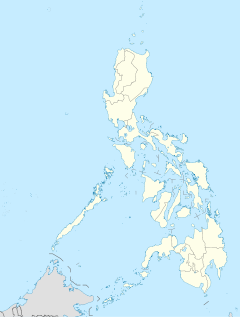- Mount Banahaw
-
Mount Banahaw 
Mt. Banahaw in 2007Elevation 2,158 m (7,080 ft) [1] Prominence 2,158 m (7,080 ft) Location Map of the Philippines Location Provinces of Quezon and Laguna on Luzon Island, Philippines Coordinates 14°04′N 121°29′E / 14.07°N 121.48°ECoordinates: 14°04′N 121°29′E / 14.07°N 121.48°E[1] Geology Type Complex volcano Volcanic arc/belt Macolod Corridor Last eruption 1843 Mount Banahaw (alternative spelling: Banahao or Banájao) is an active volcano on Luzon Island in the Republic of the Philippines. The three-peaked volcano complex is located between the provinces of Laguna and Quezon and is the tallest mountain in the CALABARZON region dominating the landscape for miles around.[2]
The mountain is considered by many as a "Holy mountain" and is popular among pilgrims along with mountain climbers. Banahaw is a national park and a protected area in the Philippines since 1941, and is now called Mts. Banahaw-San Cristobal Protected Landscape covering 10,901 hectares (26,940 acres) of land.[3][4]
Contents
Physical characteristics
The andesitic Banahaw volcano complex is composed of several mountains with Mount Banahaw, the largest with a maximum elevation of 2,158 metres (7,080 ft) asl. The summit is topped by a 1.5 by 3.5 kilometres (0.93 × 2.2 mi) and 210 metres (690 ft) deep crater that is breached on the southern rim believed to have been caused by the 1730 eruption. Prior to 1730, a lake occupies the summit crater of Mount Banahaw. The resulting flood destroyed the town of Sariaya, Quezon located below the mountain.[5]
- Other peaks:
-
- Mount San Cristobal (on the western sloper)
- Mount Banahaw de Lucban (at northeastern slope)
- Buho Masalakot Domes (at southwestern slope)
- Mount Mayabobo
- Maars: Lake Dagatan and Lake Ticab
- Thermal Areas:
-
- Tiaong-San Pablo hot/warm springs
- Bakia warm/cold springs
- Sampaloc warm springs
- Mainit hot/warm springs
- Cagsiay hot/warm springs
Holy mountain
Banahaw is a traditional pilgrimage site for locals, believed by many as a "Holy mountain", a spiritually-charged location. The mountain and its environs are considered sacred by local residents; the water from its sacred springs are deemed "holy water" for allegedly having beneficial qualities, issuing forth from locations called "puestos" or "holy sites". These sites are unique natural features composed not only of springs, but also caves, streams and boulders; with names with biblical allusions, and shrines erected in, on or around them. These locations were allegedly revealed to a man named Agripino Lontoc by the "Santas Voces" or the "Holy Voices", which also gave the names to these places way back during the Spanish Colonial Era. Another one of this mountain is the adjacent Mount Banahaw de Lucbán.[5]
Hiking activity on Banahaw
The mountain is popular not only to pilgrims but also among mountain climbers being the closest over 2,000-metre (6,600 ft) mountain from Manila. Hiking activity peaks during Holy Week each year, with climbers numbering to the thousands. At least four trails exist from Dolores, Sariaya, and other towns of Quezon located on its foothills. The most frequently used trails are the Cristalino and Tatlong Tangke, taking an average of 9 and 5 hours, respectively. These two trails originate from Barangay Kinabuhayan in Dolores, and meet near the summit, which is actually the rim of the Banahaw caldera. On the summit are viewpoints, labeled as Durungawan I, II, and III, which are the usual destination for pilgrims and hikers. Other points of interest include the "Kuweba ng Diyos Ama" (Tagalog: Cave of God the Father) and the spring at Brgy. Kinabuhayan, said to have curative powers.[5]
Pollution
Due to incessant climbing activity, and litterbugs who have no regard to the environment, the mountain trails have become littered with trash. In March 2004, the Department of Environment and Natural Resources ordered a 5-year suspension of hiking activity in the mountains, covering the Dolores and Sariaya trails. Reopening was delayed and is now scheduled in March 2012.[2][6]
Etymology
The term Banahaw is not known to many people but some beliefs attribute it to the description of a holy being. This mountain has a rock with the footprint of an unknown being and supposedly, this was the origin of the name of the mountain. Banahaw is very close to the modern Tagalog words banal (holy, sacred, divine) and daw (a word used in quoting another speaker; when appended to sentences, daw indicates slight disbelief or uncertainty in the veracity of the quotation's content). Combined, the two words mean "[it is] probably/supposedly sacred". The way the phrase was transcribed in Baybayin, the ancient syllabary used in writing Tagalog prior to the introduction of the Latin alphabet, finally produced the term "Banahaw".[citation needed]
See also
- Active volcanoes in the Philippines
- Potentially active volcanoes in the Philippines
- List of inactive volcanoes in the Philippines
- Philippine Institute of Volcanology and Seismology
References
- ^ a b "Banahaw". Global Volcanism Program, Smithsonian Institution. http://www.volcano.si.edu/world/volcano.cfm?vnum=0703-05=. Retrieved 2010-12-19.
- ^ a b "Mount Banahaw". PinoyMountaineer. 7 January 2009. http://www.pinoymountaineer.com/2009/01/mt-banahaw-still-closed-mt-cristobal.html. Retrieved 2009-03-20.
- ^ "Protected Areas in Region IV-A (CALABARZON)". Protected Areas and Wildlife Bureau. Retrieved on 2011-09-26.
- ^ "NIPAS Initial Components (PDF)". Protected Areas and Wildlife Bureau. Retrieved on 2011-09-26.
- ^ a b c "Mount Banahaw". Malapascua. Retrieved on 2011-09-25.
- ^ "Mountain News: Mt. Halcon and Mt. Banahaw status updated". Pinoy Mountaineer. Retrieved on 2011-09-27.
External links
Categories:- Mountains of the Philippines
- Volcanoes of Luzon
- Complex volcanoes
- Active volcanoes of the Philippines
Wikimedia Foundation. 2010.

